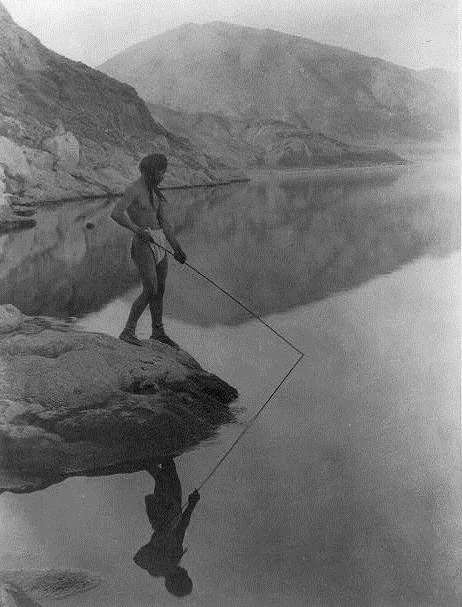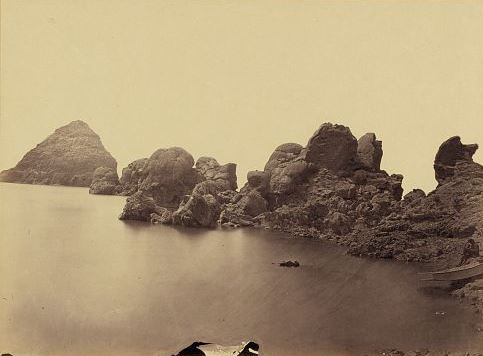Pyramid Lake is near the border of California and Nevada, just north of the city of Reno. Native people called the Cui-ui eaters (or the Paiute) lived in the area surrounding the lake. These people were fishermen who caught and ate the Cui-ui fish and the Lahonton Cutthroat Trout. When famous American explorer John C. Fremont traveled through the area in 1844 exploring for the United States government, he traded for fish and wrote about how large and tasty they were.
The Cui-ui eaters or Pyramid Lake Paiute people have lived around and fished at Cui-ui Pah or Pyramid Lake from time immemorial. Former Tribal Chairman Joe Ely explains that “the history of the Cui-ui Tuccutta is marked by many events stored in the minds of the elders who, in turn, teach the children by telling stories and legends. The legend of the Stone Mother, the story of the tribe’s origin, is the most often told story. Telling of the creation of the people, the lake, and the Cui-ui, it also sheds light on the importance of their existence.”

Library of Congress
In 1859, Major Frederick Dodge, the first agent of the Western District of the Office of Indian Affairs, requested that Pyramid Lake and Walker Lake Paiute Indian Reservations be preserved for the Cui-ui people. Dodge stated: “I respectfully suggest that the North West part of the Valley of the Truckee River including Pyramid Lake, and the North East part of the Valley of Walkers River including the lake of the same be reserved for them, the localities and boundaries of which are indicated on the accompanying map. These are isolated spots, embracing large fisheries surrounded by mountains and deserts, and will have the advantage of being their home of choice.”
But fishing was not regarded as a “beneficial use” of water in 1902, and Derby Dam was built ten miles above the Pyramid Lake Reservation boundary. The dam diverted water from the Truckee River which flows out of Lake Tahoe, down through the cities of Reno and Sparks and then north into Pyramid Lake and in the past, Winnemucca Lake. The dam carried the diverted water into the 32-mile-long Truckee Canal, which carried it to the Carson River drainage where it was used for summer irrigation in Carson Valley. Project planners said 350,000 acres of land could be reclaimed, which would “make the desert bloom.”

Library of Congress, Pyramid and domes, Pyramid Lake, Nev. / T.H. O'Sullivan, photo. Published 1867.
Derby Dam, completed in 1905, diverted 48% of the waters of the Truckee River. This huge diversion of water had dramatic effects downstream and the level of Pyramid Lake began to decline that year and continued to do so until 1967. Less and less water reached the lake and the Cui-ui people could no longer rely on fish for food. Fishing was not only important to feed the Paiute, it was also part of their identity.
The area around Pyramid Lake, including Winnemucca Lake, was designated a National Wildlife Refuge in the early 1900s. Winnemucca Lake was twenty miles long, three miles wide, and eighty feet deep. It was a major wetlands, fishery, and stop on the Pacific flyway, a path for migratory birds. Due to the construction of Derby Dam, Winnemucca Lake dried up and the plants and animals either died or had to find a new place to live. After the body of water dried up, the Refuge status was abandoned in 1938. Larger Pyramid Lake suffered from a surface drop of 87 feet by 1967, and this combined with pollution and over harvesting led to the extinction of the huge indigenous variety of the Lahonton Cutthroat Trout by the 1940s. Many Paiute fishermen on Pyramid Lake had to leave the reservation to find jobs in cities.
One white trader who had been a middleman for fish sales stated, “There was never a hungry person on the reservation, they loved that kind of work—that way of making a living, and they had a dignity, which went away after the last run of 1937. Nearly all the fishermen went off to Reno or somewhere and never came back.”
After the Endangered Species Act was passed in 1967, the Cui-ui fish was the first species on the list. The Paiute Indians complained about the devastating effects of the Derby Dam for decades. With the passage of the Endangered Species Act, the tribe had legal grounds to challenge Derby Dam. That year, the Paiute convinced the federal government to place limits on the amount of water diverted from the Truckee River. This meant that more water would flow into Pyramid Lake.
The tribe took their case all the way to the Supreme Court and in 1990 the Paiute reached a settlement with the government. While some of the water from the Truckee River was still diverted for irrigation, more water flowed into Pyramid Lake, saving the fish. This court case shed light on the dangers of diverting river water for irrigation. While beneficial for watering crops, diverting water from Pyramid Lake caused the destruction of plant and animal species and threatened the existence of the Paiute people. In 2015, the Truckee River Operating Agreement implemented the settlement and permanently ensured the survival of Pyramid Lake, the Cui-ui, and themselves, the Cui-ui Tuccutta. Through their resourcefulness, the Cui-ui people preserved Pyramid Lake and brought national attention to the destruction caused by irrigation.
Researched and written by Dr. Andrew Carey; photo research and editing by Katie Crawford-Lackey.
Visit the National Park Service Travel Bureau of Reclamation's Historic Water Projects to learn more about dams and powerplants.
Last updated: July 3, 2017
